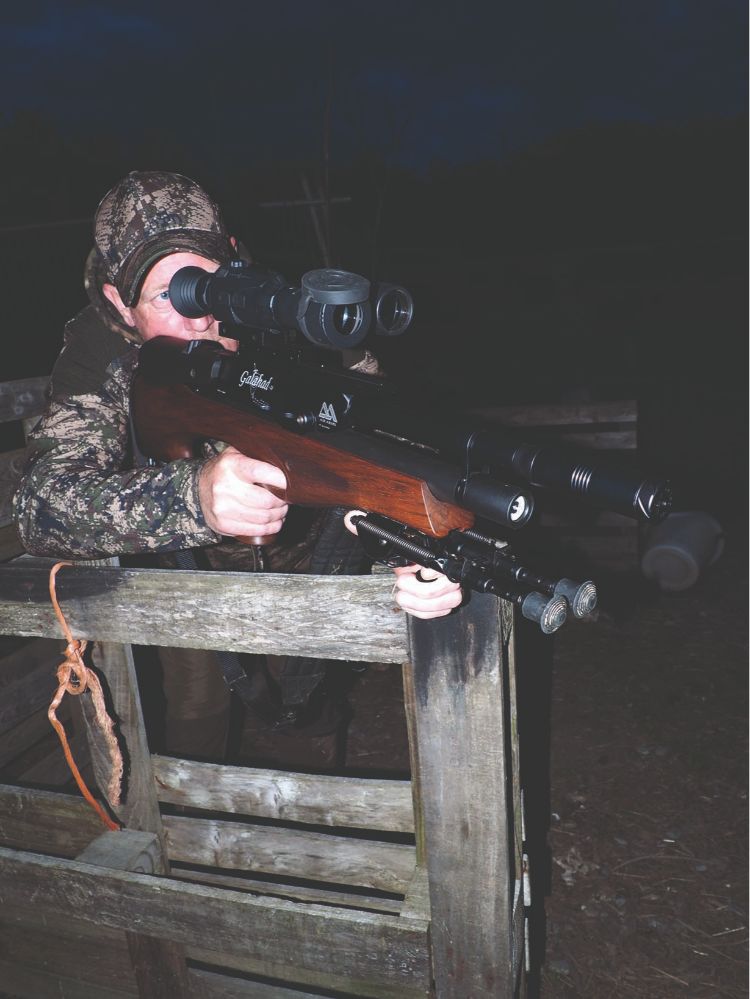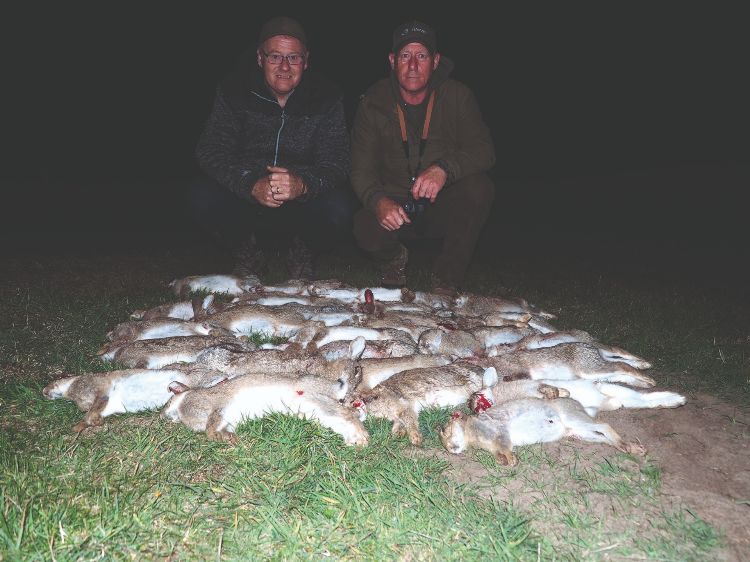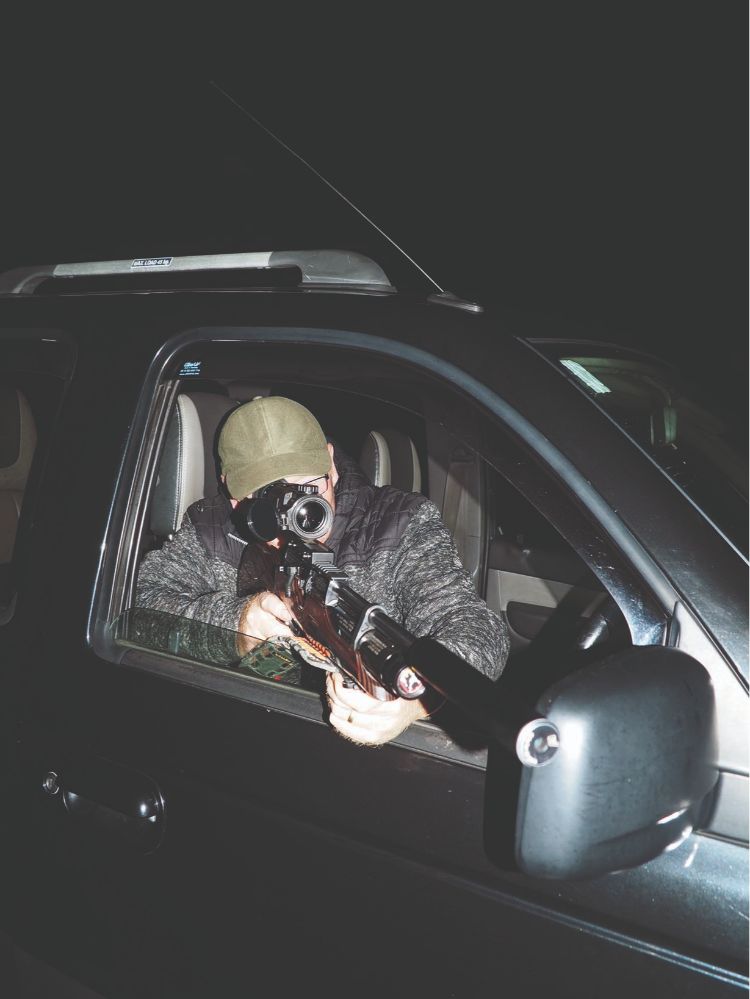I wasn't going to do a feature this month on thermal, but some readers have messaged me about the new thermal gear I am using, so I am bound to it. I have been asked a lot lately if the thermal has improved my numbers of pests shot, and if it has really given me the edge in the field. I’ve also been asked if it was really worth spending the money for the gains, if any. Well, I’m going to answer those questions here and hope that it will help you to make your mind up on both questions.
Over the last couple of years, I have shot on a couple of golf courses in the area, and I’ve had a bit of success most nights, but I always knew I should be doing better. A lot of the shooting I do here is not for leisure, I do it as a job, and my success is paramount to keep me going and showing that I can do the best job possible. People often think that you can just turn up at night with night-vision and go and eradicate everything that’s on the ground, it is not sporting, or the pests don’t have a chance, but this is definitely not true. On golf courses especially, you will have people walking dogs at night, and the rabbits soon get wise that someone with a torch and a dog is danger, so when you try to do the same without the dog it makes no difference, as soon as you turn the torch on to get a shot, they run.
THERMAL SPOTTER
Moving to night-vision certainly gives you an edge because the infrared beam doesn’t shine the rabbits up; to do that effectively and safely, I use a thermal spotter because spotting the rabbits with a hand-held thermal device is a safer option than waving a rifle around to spot the rabbits before shooting them.
So is it expensive to buy a thermal spotter? The short answer is ‘no’. For years, I have used probably the cheapest thermal on the market for this method of shooting. There are so many different products to buy these days, but you can spend £600 on a spotter that will more than do the job. I still use the £700 spotter I bought for rabbit and fox shooting – I don’t need to spend £3000 to do the job.
When using this method of hunting the rabbits, it is inevitable that the they will associate the red glow from the infrared torch with danger. You will still miss plenty of rabbits, because not every night will have a slight breeze coming across you, and it will be gusty some days, so you won’t read it right every shot.
Those missed rabbits have already associated the gear you are using with danger, others around will soon learn and the landowner is on your case because you’re not getting the results you were, and he is still getting damage on his land.
 GEAR OPPORTUNITIES
GEAR OPPORTUNITIES
Luckily for me, working in this industry gives me the opportunity to use gear that otherwise I wouldn’t buy. A lot of it is too expensive for me, but there is always a middle ground even with thermal gear, and when Hik approached me to try out their new gear, I jumped at it. I now had the opportunity to use what so many other shooters out there were using, without having to fork out thousands of pounds.
The kit they gave me was awesome! I was shooting rabbits at night and I could see fleas bouncing on them – I was in my element. The only downside is when this gear has to go back. Would I spend £3000 so I could carry on shooting rabbits with it? The answer is no because I know I can use lesser gear and still do my job effectively. So, let’s fast forward to the latest outing and see how it performed on one of the hardest courses, now it has got a bit cooler.
SWITCHED-ON RABBITS
This golf course is hard because not only do dog walkers use it, but there are poachers trying to run dogs on it most weeks, too. When I go with my buddy, Alan, we usually get around a dozen rabbits at best because the rabbits are so switched on to everything that we have at our disposal, but tonight we were going to try just thermal and see how we got on.
When we arrived at the course it was just going dark, and we could see the odd person straying off the footpaths and letting their dogs just run around everywhere. We had called the police before we started to make them aware of our presence because it’s not uncommon for someone to ring them and say ‘someone is shooting’. Letting them know in advance covers us and saves valuable police time so that they can go and help someone who really needs them.
The plan was to drive the length of the course to see what we could get, and also give us an idea of numbers. This course is an SSSI, so we only get permission to shoot at certain times of the year – usually autumn for a couple of months, so this gives the rabbits a full breeding term – good for us shooters, not so good for the golf course!
Anyway, we are driving along trying to keep 30 yards from the edge that borders the sand dunes. This is where the rabbits live, so should give us the best chance to bag a few from both sides of the truck. I could get the runners that head for home, and Alan would get the ones that think it’s still safe to feed further out. I certainly don’t mind doing this because I got plenty of shooting last year in the dunes, so I like this plan.
 DEADLY ACCURATE
DEADLY ACCURATE
We set off, and within the first 100 yards I had around 12 rabbits – the FAC Air Arms Galahad proving deadly accurate. We decided to carry on and pick up the rabbits later, so that we didn’t spook the others by getting in and out of the truck. We were halfway down the course and only had another couple between us, but we saw a person cross the course and scare a few. When we looked further down to the bottom end, though it was crazy! We’d never seen so many here before – there were rabbits ‘glowing’ everywhere. We were like kids in a sweet shop. It was unbelievable what we were seeing.
We carried on toward the rabbit mass, still driving because it had worked well so far, but as we approached, we noticed that a lot of the rabbits started to run before we got as close as 100 yards. We managed to shoot a few as we went along, but they are all probably three-quarters grown and we sensed that the runners were the older, wiser ones – clearly, we were shooting the thick, younger ones.
WE WANTED MORE!
We reached the bottom of the course and took time to sit and watch how long it would take for them to come back out to feed. After a good 30 minutes, we were already looking at 40 rabbits back out. They had taken no time at all to think they were safe to carry on doing what they want to do. We had around 40 rabbits shot and the course owners would have been more than pleased with that, but we wanted more. We decided that we would drive halfway back up the course, and then I’d get out and try to stalk a few that were way out. I knew that I could use bunkers and raised ground to get within distance, just for a change and I prefer to hunt the rabbits rather than drive around shooting, but this is a job and numbers are what bring in repeat customers.
DISASTER STRIKES!
We’d done a steady hour of driving and walking, and we had picked off a few as we went, so we decided to put the rifles away and go and collect what we’d shot. We should have had around 60 rabbits to collect, and this is more than enough for a night’s work – well, a couple of hours, but the owners didn’t know that.
We started finding the rabbits, but then disaster – the amount of dune grass that had grown from last year was remarkable! We knew for a fact where we’d shot the rabbits, but finding them was nothing short of impossible. I was knee deep, with the thermal spotter and a torch, but we were struggling to find half of the rabbits we’d shot. We did see a couple of foxes take some of the bunnies, but no way could they have taken so many! We ended up collecting around 25 rabbits, and we were devastated, but it was a lesson learned for future visits. The plan will be changed on how and where the shots will be taken, to make sure that we retrieve what we shoot.
 LESSONS LEARNED
LESSONS LEARNED
What did I learn from the kit used? Well, last year when we used night-vision and the rabbits headed for the dunes, they wouldn’t stop until they were well over 70 yards from the course. This session, though, we found that because there were no lights, or red glow, plenty ran no further than 30 yards into the long grass, and then just sat there. Unfortunately, with the thermal you can’t see how long the grass is, and they look as if they are sitting in small, open pockets – but they are not.
So yes, the thermal gear got us plenty more shots, but in the long run it was impossible to find them afterwards. Also, the kit I was using is the basic £995 thermal, and I shot just as many as Alan who was using a scope three times more expensive. So if you have the desire to use thermal-imaging to do a job on rabbits, or rats, you can afford to do it because the gear is out there to use – just don’t expect the image to be like your mate’s £3000 scope. Also, make sure the rabbits are retrieved straight away if in cover because the thermal gear doesn’t tell you in detail how bad that cover is for later retrieval – no matter how much it costs.